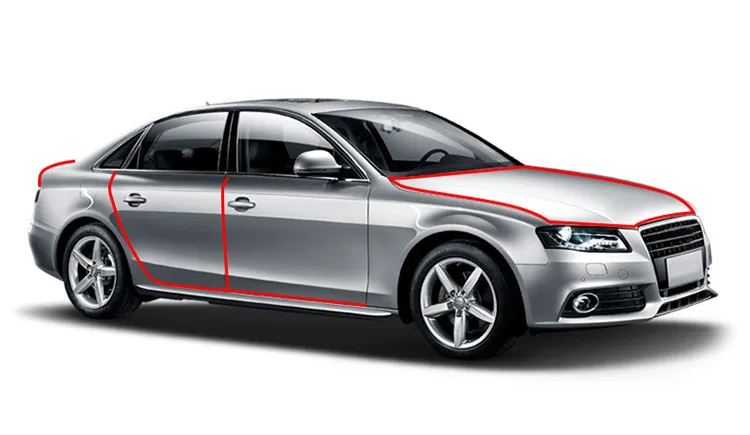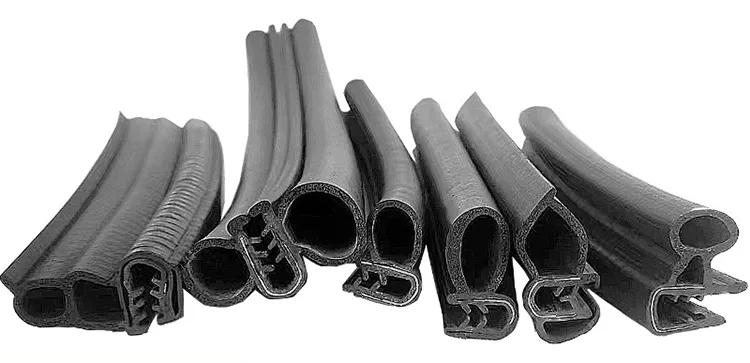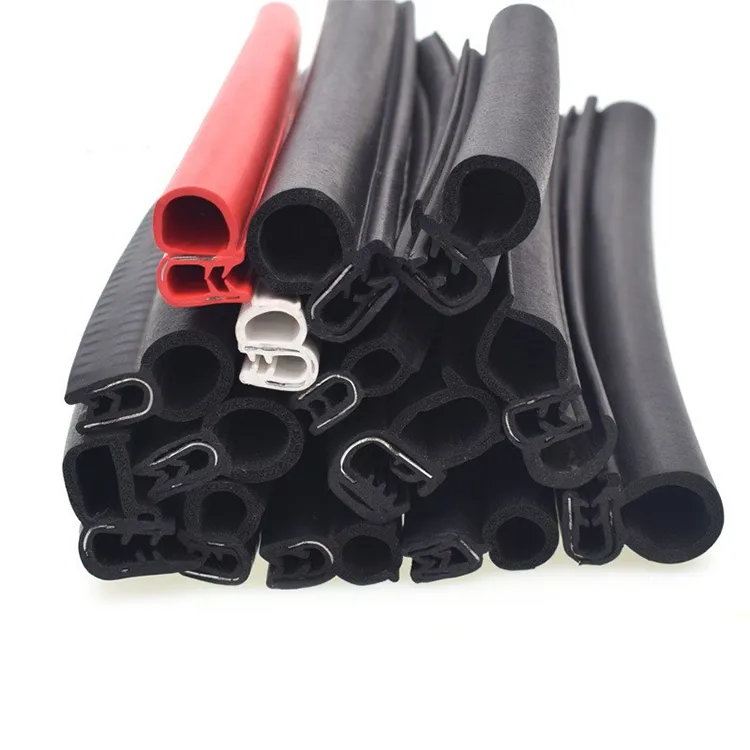1. Introduction
When I talk about automotive sealing strips, I am referring to the essential components that sit quietly along the edges of doors, windows, trunks, and hoods. At first glance, these strips may look simple, but they play a critical role in a vehicle’s comfort, safety, and durability. They keep out water, dust, and wind, while also reducing noise and protecting metal surfaces from corrosion. Without well-designed sealing strips, even the most advanced vehicles would quickly lose efficiency and performance.
Among the different types of sealing strips used in modern cars, metal-reinforced sealing strips have become one of the most widely adopted. Unlike standard rubber strips, these products combine the flexibility of elastomer materials with the strength of an internal metal carrier. The result is a seal that not only grips firmly to vehicle flanges but also retains its shape and effectiveness even after years of use and exposure to harsh conditions.
In this article, I will explore the common cross-section designs of automotive sealing strips, the role of metal reinforcement in ensuring durability and stability, and a material comparison between EPDM and silicone rubber. By the end, you will have a clear understanding of how these components are designed and why choosing the right type of sealing strip can make such a difference in automotive performance.

2. Common Cross-Section Shapes of Automotive Sealing Strips
One of the fascinating aspects of automotive sealing strips is how their cross-section shapes are engineered to solve very specific sealing challenges. A car isn’t built with uniform gaps—the spaces around doors, windows, trunks, and hoods vary in width, pressure requirements, and movement. This is why sealing strips come in many different profiles, each designed to balance compression, elasticity, and durability.
Key Cross-Section Profiles
- D-shape – This profile offers excellent elasticity and is most commonly used for car doors and windows. The rounded “D” design compresses smoothly, providing consistent sealing against water and wind.
- E-shape – Compact and efficient, the “E” profile is often used for narrow gaps. Its multiple lobes improve sealing efficiency, making it suitable where space is limited but a strong barrier is needed.
- U-shape – Perhaps the most versatile profile, the “U” is frequently reinforced with metal for added grip. It easily clips onto body flanges and stays secure during vibration or movement, making it a preferred choice for door frames and edges.
- P-shape – Widely applied in trunk and hatchback sealing, the “P” design combines a tubular bulb with a flat base, ensuring reliable compression and weather resistance when the trunk closes.
- L / V / J shapes – These specialized profiles are tailored for corners, angled joints, or areas exposed to repeated vibration. Their angled designs allow them to adapt to unique structural challenges without compromising performance.
- Oval / Tubular profiles – With hollow, rounded forms, these profiles excel in compression resistance and long-term durability. They are typically used in areas exposed to higher loads or repeated opening and closing.
Golden tip: The right sealing strip profile is not one-size-fits-all. Choosing the correct cross-section depends on factors such as the installation area, compression force, environmental exposure, and sealing requirements. A well-matched profile not only ensures effective sealing but also extends the service life of the vehicle’s components.

3. The Role of Metal Reinforcement
While rubber alone provides flexibility and sealing performance, it sometimes lacks the structural strength to stay in place under constant stress. This is where metal reinforcement becomes indispensable. By embedding metal carriers within automotive sealing strips, manufacturers create products that combine elasticity with long-lasting stability.
Why embed metal in sealing strips?
- Structural stability and shape retention – The metal skeleton helps the strip maintain its original form, even after repeated compression from doors, windows, or trunks. Without reinforcement, rubber alone may deform over time.
- Enhanced gripping force – A reinforced “bite” ensures the strip attaches firmly to vehicle body flanges, resisting slippage during vibration, impact, or temperature changes.
- Prevention of displacement and wear – Metal reinforcement reduces the risk of the strip shifting out of place, which could otherwise compromise sealing effectiveness and cause noise or leaks.
Types of metal carriers
- Steel wire – Provides high strength and rigidity, ideal for areas requiring maximum grip.
- Perforated steel plate – Offers both strength and flexibility, with holes that allow the rubber to bond tightly during extrusion.
- Aluminum strips – Lightweight and corrosion-resistant, making them suitable for applications where reducing overall vehicle weight is a priority.
| Metal Carrier | Advantages | Limitations |
|---|---|---|
| Steel wire | Strong, durable, excellent retention | Heavier, may corrode if not treated |
| Perforated steel plate | Balanced flexibility and strength, secure bonding | Slightly heavier than aluminum |
| Aluminum strip | Lightweight, corrosion-resistant | Lower strength compared to steel |
Case examples
- Door frame seals with steel reinforcement – These strips must withstand constant opening and closing while maintaining a tight seal. Steel reinforcement ensures the strip stays firmly attached to the flange over years of use.
- Sunroof seals with aluminum carriers – Here, flexibility and corrosion resistance are critical. Aluminum reinforcement allows the seal to bend along complex curves while resisting moisture and oxidation.
Key takeaway: Metal reinforcement transforms a simple rubber strip into a durable, precision-fit sealing component that ensures long-term performance in demanding automotive environments.
4. Material Comparison: EPDM vs. Silicone Rubber
When selecting automotive sealing strips, the choice of rubber material is just as important as the cross-section shape or metal reinforcement. Two of the most commonly used materials are EPDM and silicone rubber, each offering unique performance advantages depending on the application.
EPDM (Ethylene Propylene Diene Monomer)
EPDM is one of the most widely used elastomers in the automotive industry. It offers excellent weather resistance, which makes it ideal for outdoor applications exposed to sunlight, rain, and ozone. Its elasticity allows it to maintain a reliable seal while absorbing vibration and compression. In addition, EPDM is cost-effective, making it a practical solution for high-volume production. This is why most automotive doors, windows, and general sealing areas rely on EPDM as their primary material.
Silicone Rubber
Silicone rubber, while more expensive, is valued for its superior performance in extreme environments. It maintains flexibility across a wide temperature range, from freezing cold to high-heat conditions. Silicone is also highly resistant to ozone, UV light, and environmental aging, ensuring consistent performance over long service life. Because of these properties, silicone rubber is often used in specialized applications such as electric vehicles, railways, aerospace, or premium-class automobiles that demand both safety and durability under severe conditions.
Side-by-Side Comparison
| Property | EPDM | Silicone |
|---|---|---|
| Temperature resistance | -40°C to 120°C | -60°C to 200°C |
| Weather/Ozone resistance | Very good | Excellent |
| Elasticity & softness | Good | Excellent |
| Cost | Lower | Higher |
| Applications | Doors, windows, general sealing | High-temp, EV, railways, premium cars |
Practical insight: For most standard vehicle sealing needs, EPDM provides the best balance of performance and cost. However, when designing for extreme conditions or premium markets, silicone rubber becomes the preferred choice despite its higher price point.
5. Conclusion
Automotive metal sealing strips may look like small details in vehicle design, but their role is anything but minor. The right cross-section profile ensures that every gap in a vehicle is sealed efficiently, whether it’s around a door, trunk, or sunroof. The addition of metal reinforcement gives these strips the structural strength they need to stay in place and perform consistently over years of use. Finally, the choice of rubber material—EPDM or silicone—determines how well the strip stands up to environmental conditions, temperature extremes, and cost requirements.
For me, these three factors—shape, reinforcement, and material—form the foundation of a reliable sealing solution. They directly affect vehicle comfort, safety, and durability. As automotive technology advances, so too does the demand for better sealing solutions, from standard passenger cars to electric vehicles and high-performance applications.
At Kinsoe, our team specializes in delivering customized automotive metal sealing strip solutions designed to meet the unique requirements of each project. Backed by more than 20 years of expertise in extrusion and molding, and supported by state-of-the-art production facilities, we ensure that every product consistently meets stringent international standards for quality, precision, and performance.
If you are looking for sealing solutions that combine precision engineering, durability, and flexibility, I invite you to consider Kinsoe as your trusted partner.
Related Articles
Types of Rubber Seals by Shape, Material, and Use
Understand various rubber seal types, their material properties, and how to select the right seal for specific automotive and industrial applications.
Common Seal Leakage Problems and Effective Solutions
Learn about frequent sealing failures in equipment, including how proper strip design and material selection prevent leaks and wear.
Static vs Dynamic Seals: Guide to Reliable Sealing
Explore the differences between static and dynamic seals, including design tips, material considerations, and automotive use cases.

